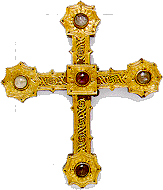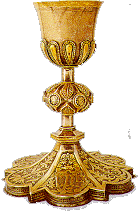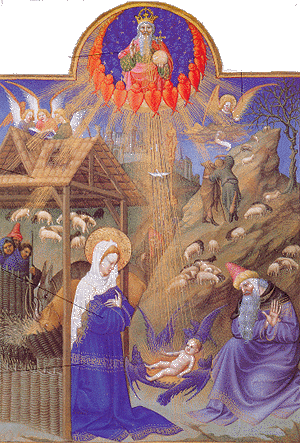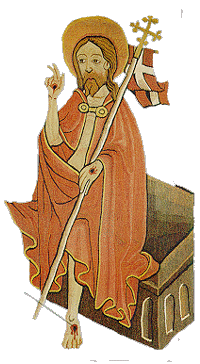 Christianity Christianity |
 Christianity Christianity |
| The Creeds | The Bible | The Trinity | The Eucharist | Two major holidays | The Virgin Birth |
While many of the different Christian churches have
their own creeds (or statement of beliefs), there are two which are relatively
universal, the Nicene Creed and the
Apostle's Creed.
The Nicene Creed
Written during the 4th century in an attempt to unify
Christians, this creed was named after the first ecumenical council of
Nicea (325). It was adopted by the Christian church in 451. Its central
doctrines are those of the Person of Jesus Christ and the reality of the
Holy Spirit. It is the only creed accepted by all three major branches
of Christendom including Protestant, Roman Catholic and Eastern Orthodox
Christians.
The Nicene Creed |
The Apostles' Creed was developed between the second and ninth centuries as a baptismal creed for new Christians. It is the most popular creed used in worship by Western Christians. Its central doctrines are those of the Trinity and God the Creator. According to legend, the Apostles (Christ's 12 main followers) wrote this creed on the tenth day after Christ's ascension into heaven. That is not the case, though the name stuck.
This is the modern English version:
The Apostles' Creed |
The Bible is the name of Christian's holy book. "Book" is a misnomer, since it is actually comprised of many books. It has two main parts: The Old Testament, which is the books of the Jewish Pentateuch (these are the five books supposedly written by Moses: Genesis, Exodus, Leviticus Numbers and Deuteronomy) as well as more books that tell the story of the Jewish people. This is important to Christians for Jesus was a Jew, and his coming was seen as a way to spread the covenant between God and the Jews to all other peoples. (See Contents of the Bible.)
Not all Christian groups agree on exactly how many books belong to the Old Testament (this is called being canonical), but included in all groups are the majestic poetry of the Psalms; the beautiful love poetry of "The Song of Solomon"; and the prophecies of the coming Messiah.
The Apocrypha are fourteen books of the Bible included in the Vulgate version of the Bible (the authorized Latin version of the Bible used by the Roman Catholic Church), but considered uncanonical by some Protestant groups. The Deuterocanonicals are 15 books accepted by the Roman Catholic Church as canonical. These two groups overlap, so combined there are 15 in all. For most people other than scholars, the issue of "canon" is an obscure part of the history of the Church's struggles and need not be a problem.
The New Testament is comprised of the books that are the fulfillment of the promises of the Old Testament. The first four books are the most sacred and important part of the Bible, The Gospels. Traditionally written by four inspired authors, Matthew, Mark, Luke and John, these books tell the story of the Angel Gabriel's annunciation to Mary, the birth of Jesus, His life and miracles, His ultimate crucifixion and resurrection, and His final ascension into Heaven.
The New Testament also includes a book about the actions of the apostles and the early church in the years following Jesus's resurrection, and the epistles (or letters) of several of the apostles, but mostly Paul, to early Christian groups. The last book of the Bible is a very mystical book called "The Revelation to John" (or Revelations), which relates a dream of the end of the world sent by God to John.
For Christians, God has three "faces": God the Father, God the Son and God the Holy Spirit. They are three-in-one and one God only.
The Father is the Creator of Heaven and Earth and all of the Universe. We use He as a bit of a shorthand and to help human conceptualize him, but he is genderless, both male and female, and beyond human comprehension.
The Son is Jesus, true man and true god, born of a woman, Mary, in Bethlehem around 2000 years ago. He is the Savior of humans, sometimes called "The Redeemer," and became incarnate to help humans "see" God. He also was crucified to redeem the sins of humans, but triumphed over Death and rose again three days later. (see Easter).
The Holy
Spirit (or
in early literature, the Holy Ghost) is just
that, the spirit of God. Sometimes called "The Revealer,"¨ it
is as The Spirit that God comes to people to help. According to Christians,
when the Gospels were being written, the writers were inspired by the Holy
Spirit. And it was the Holy Spirit which impregnated Mary. This aspect
of God is often depicted as a dove, or a dove with a flaming heart or head
in much Christian art.
The Eucharist
 |
This is the central rite of Christian celebration
and is also called The
Lord's Supper or Communion.
During this ceremony bread and wine (or grape juice in some groups) are
consecrated by a minister or priest and eaten by the congregation. This
is done at the order of Jesus, who said at the Last Supper, "Do
this in remembrance of me."
For the Catholic Churches as well as some Protestant
Churches this is regarded as a sacrament which symbolizes and effects the
union of Christ with the believers.
In the 16th century, Protestant reformers offered several different views on this including the doctrine of consubstantiation. |
 |
Right: Picture showing the story of Christ's birth, from a 15th-century book. The painting shows the dress and styles of the time when it was painted. Topmost: God the father watches from heaven, holding the world in his hand and worshipped by angels. Second to the top: Angels announce the birth to surprised local shepherds. Front: Mary and Joseph dressed in blue, the colour of divinity and heaven. (Langley 49) |
Left: Ressurection (Langley 51) |
 |
Christians
believe that Mary, a pious unmarried
Jewish girl, was the mother of Jesus and that his "father"¨ was the
Holy Spirit. She was a virgin when her Son was born, but she married
Joseph before her son was born. Joseph
was a pious Jewish carpenter who in a dream was told not to repudiate his
pregnant fiance. He brought up Jesus as his own son, and is called St.
Joseph by most Christians.
Annunciation In Leonardo da Vinci's
painting Mary is sitting in a garden when Gabriel appears to her; outdoor
settings were common in Italian Renaissance art.
(Hallam 60)
Catholics believe that Mary remained a virgin for
the rest of her life, but Protestants, relying on Biblical references to
Jesus's brothers, believe that she went on to have other children with
Joseph. But both groups agree that she was a virgin when she gave
birth to Jesus.